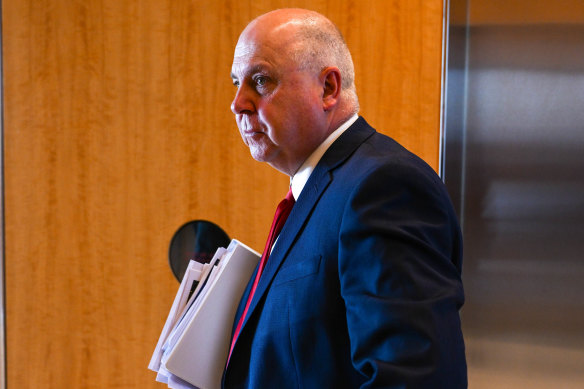- Analysis
- National
- Victoria
- Victorian budget
This was published 1 year ago
Victoria the ‘basket case’ state: This debt isn’t like a household mortgage
Tim Pallas would like us to think of the thumping great debt owed by this state as a home owner might a mortgage.
As the treasurer puts it, the size of your loan might seem scary now but over time, as your income increases, the burden becomes a little easier to carry. Similarly, “as your economy grows, your capacity to service your liability massively improves”, Pallas says.

Treasurer Tim Pallas delivering his 10th Victorian budget.Credit: Joe Armao
Most home owners also understand that if you are serious about getting your mortgage under control, you can’t keep borrowing more money to pay for other things.
This is where Pallas’ budget day analogy breaks down, along with any claim the Victorian government can reasonably make about turning around the state’s parlous fiscal position.
Over the four financial years covered by the budget, the annual interest required to service Victoria’s debt will jump from $6.3 billion to $9.3 billion. This is a serious chunk of change and, as a statistical quirk, the fastest-growing expenditure item listed on the government’s cash flow statement.
Victoria’s net debt – the total amount we owe – is forecast to pass $187.8 billion by July 2028 on the way to an unknown, distant peak. It is unfair to characterise it as a mountain because, at this point, there is no downward slope discernible to Treasury officials.
“As a proportion of gross state product, Victoria’s net debt is going to be higher than it was at the end of the Cain/Kirner years,” says economist Saul Eslake. “If I was a Victorian taxpayer, I would be worried about that.
“Certainly outside of Victoria, everyone thinks Victoria is a basket case.”
You won’t find that embossed on any government-issued licence plates.
Pallas claims as a virtue that Victoria’s net debt, when measured as a proportion of gross state product, has “stabilised” at levels that condemned a previous Labor government to electoral oblivion.
Is it reasonable to think, as Pallas contends, that the Victorian economy – pump-primed by record levels of government spending – can grow the state’s finances out of this mess? Eslake is not convinced: “The only way the debt stops rising in dollar terms is by running cash surpluses.”
There are operating surpluses but no cash surpluses forecast in the four years covered by this budget.
A simpler way of assessing this budget is to consider what is happening right now.
In the six months since Pallas published his last update of Victoria’s finances, the bottom line has gone backwards by $2 billion.
In the mid-year budget review tabled in December, the cash deficit for 2023-24 – the total revenue raised by the government less everything it spends – was forecast to be $13.1 billion. On Tuesday, that figure was revised to $15.2 billion.
This is happening despite unemployment in Victoria being at a 50-year low, business investment staying strong in the face of the government’s tax hikes and, as a consequence, the state raising more revenue than it thought it would six months ago.
The revenue boost isn’t due to the one-off, additional $3.7 billion Victoria received in last year’s GST carve-up. Rather, it is a revision of forecast revenue from all sources calculated after that deal was done and accounted for.
For David Hayward, the emeritus professor of public policy and the social economy at RMIT, the equation is both perplexing and disappointing.
“When you look through the long ranges of initiatives, this isn’t a tight budget, this is a generous budget across recurrent initiatives and, also, capital initiatives,” he says. “There is an enormous amount of spending going on.
“I would have hoped that, in particular, the budget would have returned to operating surplus this year, and if they weren’t going to do that, they would have pared back capital spending. There is no paring back or apparent restraint. They haven’t really started.”
Pallas says his budget contained “disciplined and sensible” decisions. “We are talking very large numbers here that will confront and confound people, but I can assure Victorians that our priorities are to honour the commitments we gave them, to recognise the material circumstances of the time, and to do no harm to the continuing growth and resurgence of the Victorian economy,” he says.
The likely size of that growth is now a point of contention. The budget assumes the state economy will grow by 2.5 per cent next financial year and by 2.75 per cent in the following years.
An hour after Pallas tabled his budget in parliament, the Reserve Bank of Australia downgraded its national growth forecasts. This is consistent with an increasingly gloomy global growth outlook held by the International Monetary Fund and the assumptions likely to underpin next week’s federal budget.
Eslake described last year’s state budget, the first after Labor’s re-election to a third term of government, as a wasted opportunity. This year, he sees the absence of any significant change in fiscal course under Premier Jacinta Allan as cause for sharper concern.
On the eve of this budget, S&P Global Ratings analyst Anthony Walker said that, at a minimum, he wanted the government to use its GST windfall to bank a small operating surplus next financial year. “If the government can’t deliver that, we would have growing concerns over the rating,” he says. Instead, the forecast deficit more than doubled.
The Victorian government is already rated below every other state government in Australia. If a growing state economy is going to come to its rescue, it has some heavy lifting to do.
Get the day’s breaking news, entertainment ideas and a long read to enjoy. Sign up to receive our Evening Edition newsletter here.